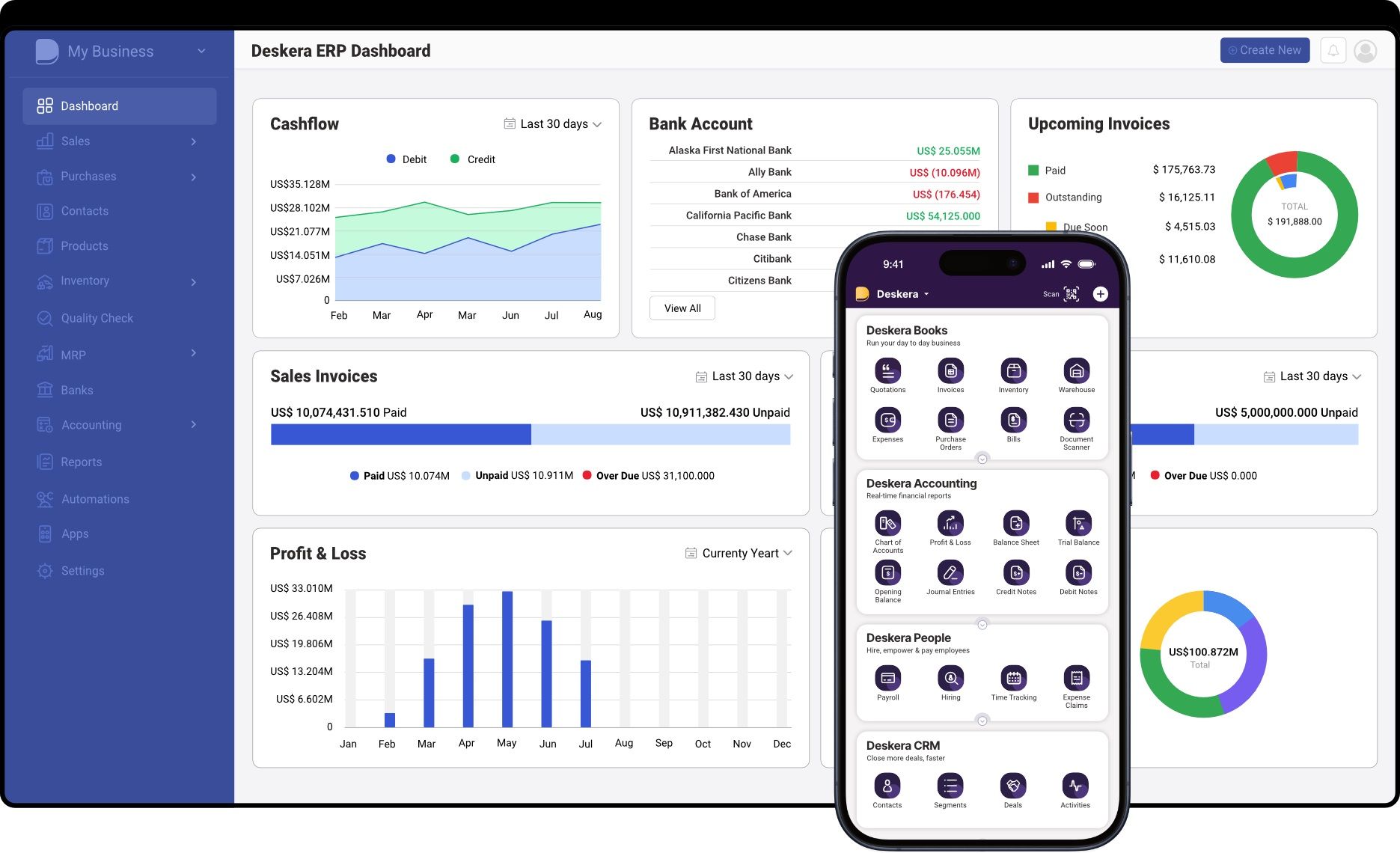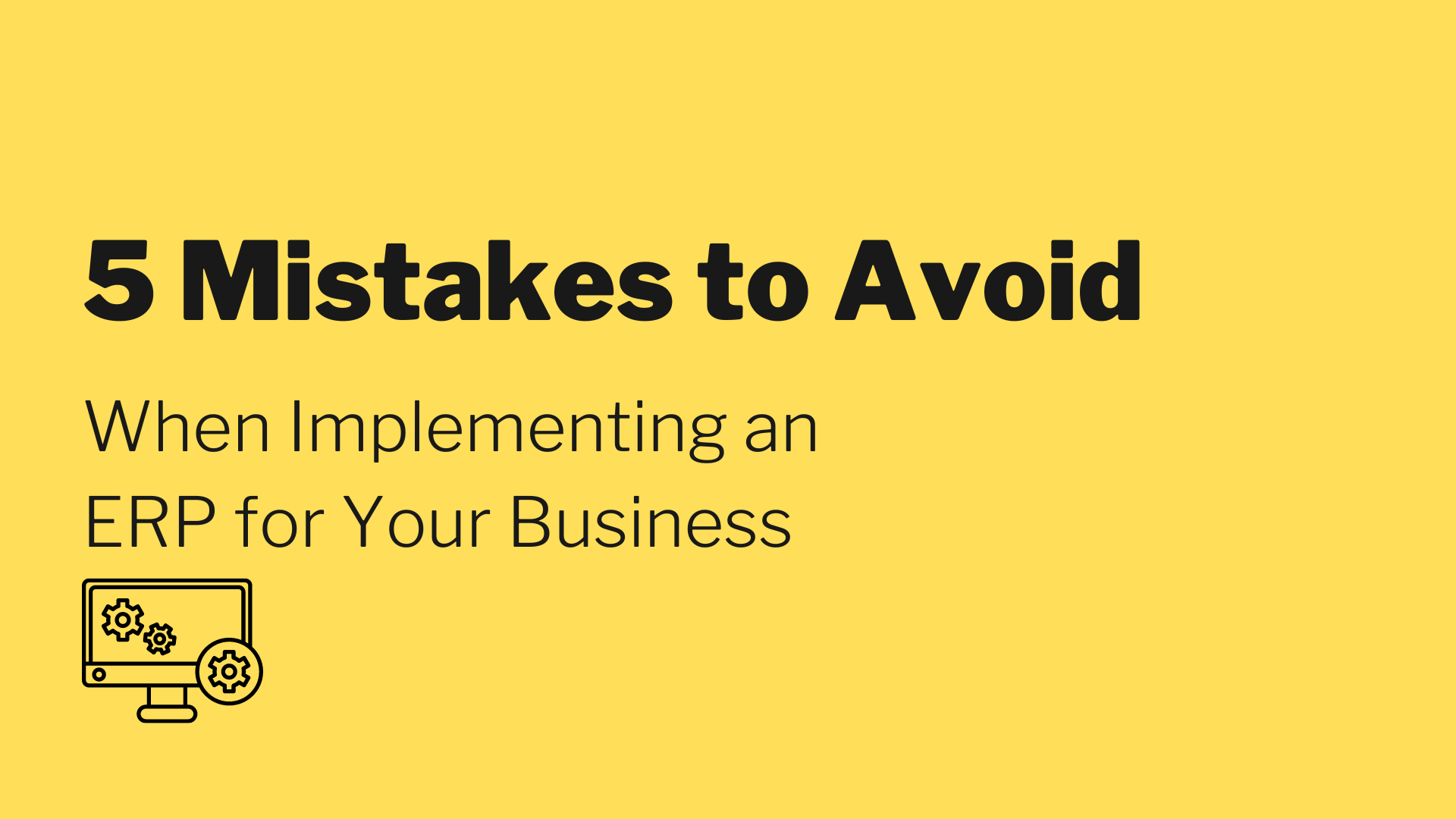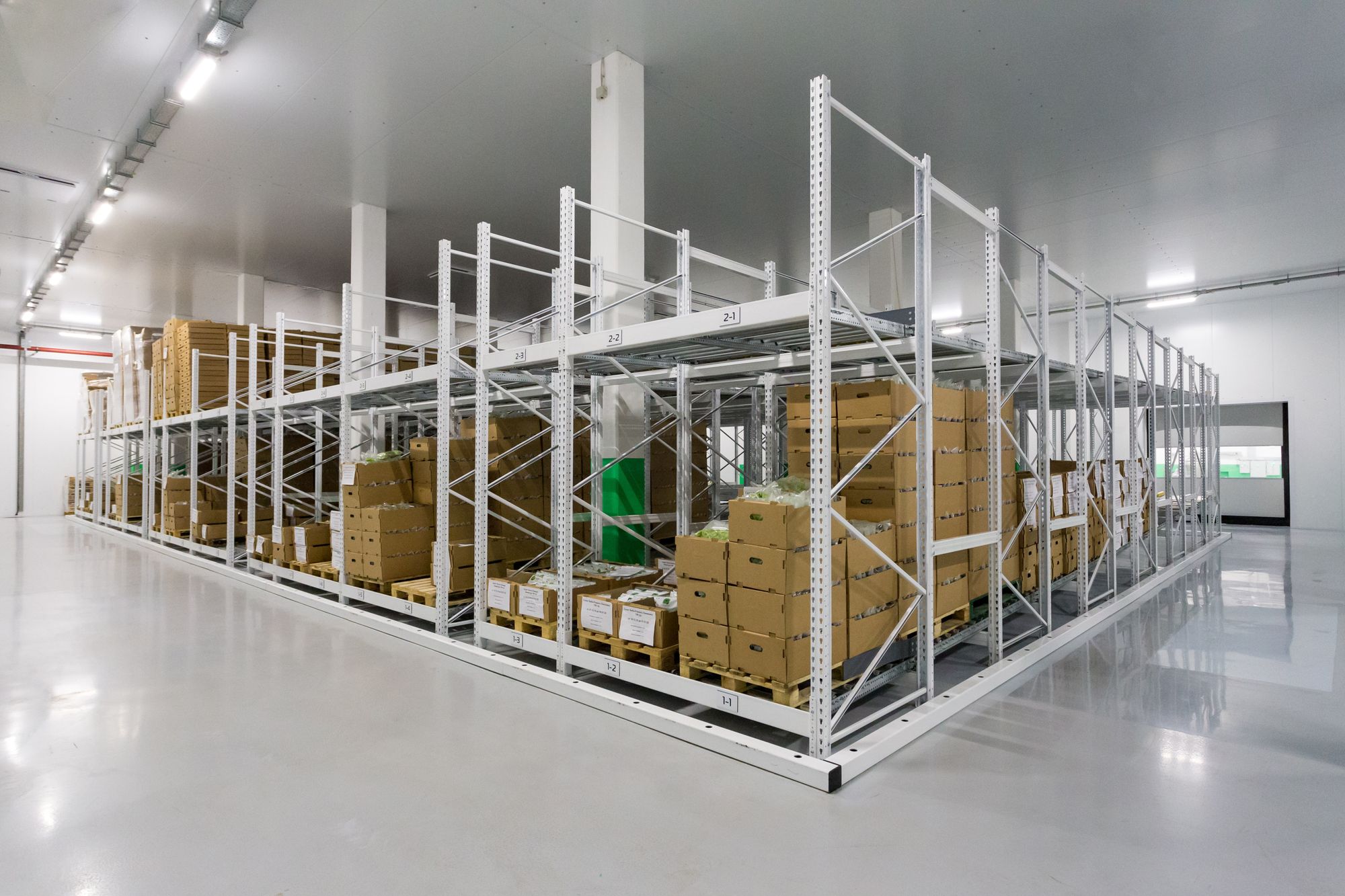Enterprise Resource Planning (ERP) systems have become indispensable tools for modern businesses striving for efficiency, integration, and scalability in their operations. However, implementing an ERP solution is not a straightforward task; it involves a structured process known as the ERP implementation lifecycle.
Despite the flood of online management platforms, ERP has maintained its position as the top choice for most financial companies. Approximately 64% agreed to leverage their services over the next three years. This is because more than 95% of businesses report improved processes after ERP implementation.

Successful ERP implementation can have numerous benefits and is crucial for organizations in today's business environment. One prominent player in the ERP arena is Deskera ERP, renowned for its comprehensive suite of modules designed to address the diverse needs of businesses across different industries.
Throughout the ERP implementation lifecycle of Deskera ERP, it provides robust support, guiding businesses through each phase to ensure a smooth transition and optimal utilization of the system's capabilities.
In this article, we will take you through the ERP implementation lifecycle. So, let’s begin.
What is ERP Implementation Lifecycle ?
The ERP implementation lifecycle refers to the structured process that organizations undergo when integrating an Enterprise Resource Planning (ERP) system into their business operations.
It encompasses a series of phases, each with its own objectives, tasks, and milestones, aimed at effectively planning, deploying, and optimizing the ERP solution to meet the organization's needs.
The key stages typically include:
- Initiation and planning
- System selection and evaluation
- Design
- Development and testing
- Training and deployment
- Post-implementation support and optimization.
Throughout the ERP implementation lifecycle, organizations aim to align the ERP system with their business processes, enhance operational efficiency, and drive business growth.
However, implementing an ERP system is a complex undertaking that requires careful planning, execution, and management. To ensure a successful ERP implementation, organizations follow a well-defined ERP implementation lifecycle.
Benefits of ERP Implementation Lifecycle
The ERP implementation lifecycle offers several benefits to organizations aiming to integrate an ERP system effectively:
- Structured Approach: Following a defined lifecycle ensures that the ERP implementation process is well-organized, reducing confusion and streamlining efforts.
- Risk Mitigation: By breaking the implementation process into manageable stages, organizations can identify and address potential risks early, minimizing the chances of costly errors or delays.
- Alignment with Business Needs: Each phase of the lifecycle focuses on aligning the ERP system with the organization's specific requirements and objectives, ensuring that the solution meets the company's unique needs.
- Efficiency and Accountability: Clear milestones and objectives within each phase promote accountability among team members and stakeholders, driving efficiency and progress.
- Optimized Resource Allocation: The lifecycle approach helps organizations allocate resources—including time, budget, and personnel—more effectively, optimizing the use of available resources throughout the implementation process.
- Continuous Improvement: Post-implementation support and optimization phases ensure that the ERP system evolves with the organization's changing needs, fostering ongoing improvement and innovation.
- Enhanced User Adoption: Proper planning, training, and support throughout the lifecycle contribute to smoother user adoption, as employees become familiar with the new system and its benefits.
- Improved Decision-Making: With integrated data and streamlined processes provided by the ERP system, organizations can make informed, data-driven decisions more quickly and accurately.
Overall, the ERP implementation lifecycle serves as a strategic roadmap, guiding organizations through the process of adopting and integrating an ERP system while maximizing efficiency, minimizing risks, and driving long-term business success.
What are the Stages of ERP Implementation Lifecycle?
Understanding the stages of the ERP implementation lifecycle provides organizations with a roadmap to seamlessly integrate this transformative technology into their operations, ensuring efficiency, alignment, and success.
The 3 main stages involved in ERP implementation lifecycle are:
Stage 1: Pre-Implementation of ERP
During the pre-implementation stage, organizations conduct thorough assessments, define project goals, establish budgets, and select key stakeholders to lay the groundwork for a successful ERP deployment.
Thus, the phases involved in the stage 1 of ERP implementation lifecycle are:
Establishing Clear Objectives and Scope
Before embarking on an ERP implementation, it is crucial to define clear objectives and determine the scope of the project.
This involves identifying the specific business processes and areas that the ERP system will address.
Understanding the organization's goals, pain points, and desired outcomes will provide a foundation for the subsequent steps in the pre-implementation phase.
Conducting a Comprehensive Needs Analysis
A thorough needs analysis is essential to identify the requirements and challenges that the ERP system must address.
This involves engaging key stakeholders, such as department heads, process owners, and end-users, to gather insights and document existing processes.
The needs analysis should encompass various aspects, including functional requirements, technical infrastructure, data migration, integration needs, and compliance considerations.
Evaluating ERP Solutions
Once the requirements are documented, it's time to evaluate different ERP solutions available in the market.
This step involves conducting extensive research, gathering information from vendors, attending demos, and assessing the compatibility of each solution with the organization's needs.
Factors to consider during the evaluation include the system's functionality, scalability, flexibility, vendor reputation, support services, and total cost of ownership.
Building the Implementation Team
Assembling a competent implementation team is vital for the success of an ERP project.
The team should comprise individuals with a diverse range of skills and expertise, including project managers, functional and technical consultants, subject matter experts, and IT personnel.
Assigning clear roles and responsibilities to each team member will help streamline the implementation process and ensure effective collaboration.
Creating a Realistic Implementation Plan
Developing a detailed and realistic implementation plan is a critical step in the pre-implementation phase. The plan should outline the project timeline, milestones, deliverables, resource allocation, and budgetary considerations.
It should also identify potential risks and mitigation strategies. By setting clear objectives and a well-defined roadmap, the implementation team can stay on track and manage expectations effectively.
Preparing the Infrastructure and Data
A successful ERP implementation requires a robust IT infrastructure capable of supporting the new system. This may involve upgrading hardware, network, and security measures to meet the ERP system's requirements.
Additionally, data migration plays a crucial role in the pre-implementation phase. Identifying the data sources, cleansing and transforming the data, and ensuring data integrity are key activities during this stage.
Change Management and Training
Change management is an integral part of ERP implementation. The pre-implementation phase should include a comprehensive change management plan to prepare employees for the upcoming changes and address any resistance.
This may involve conducting training sessions, workshops, and communication campaigns to ensure the smooth adoption of the new system. Engaging employees and involving them in the process can greatly enhance user acceptance and minimize disruptions.
Conducting Pilots and Testing
Before rolling out the ERP system across the entire organization, it is advisable to conduct pilots and extensive testing. Pilots involved in implementing the system in a limited environment or a specific department validate its functionality and identify any potential issues.
Testing should encompass various scenarios, including integration testing, performance testing, and user acceptance testing, to ensure the system operates as expected
Stage 2: Execution
The second stage of ERP implementation is a critical phase where the foundation for success is laid.
By defining requirements, balancing customization and configuration, migrating data, training users, and ensuring seamless integration, organizations can minimize disruption and maximize the benefits of their ERP system.
Collaboration, communication, and adaptability are key throughout this stage, enabling organizations to pave the way for a successful ERP implementation.
Thus, the phases involved in the stage 2 of ERP implementation lifecycle are:
Defining Requirements
The second stage kicks off with a comprehensive analysis of business requirements. It involves engaging stakeholders from various departments to gather their unique needs, pain points, and desired outcomes.
This process requires open communication, collaboration, and a deep understanding of the organization's workflows.
The goal is to identify gaps and align the ERP solution with the specific requirements of the business.
Customization vs. Configuration
During the requirements analysis, you'll encounter decisions regarding customization and configuration. While it's tempting to customize the ERP system to fit every individual need, it's crucial to strike a balance.
ERP systems often come with robust configuration capabilities that allow tailoring the software without making extensive code modifications.
Leveraging configuration options ensures easier maintenance, and smoother upgrades, and reduces the risk of creating a system that's too complex to manage effectively.
Data Migration
One of the critical aspects of the second stage is planning and executing the migration of data from legacy systems to the new ERP platform.
This involves careful mapping, cleansing, and validation of data to ensure accuracy and completeness.
Data migration can be a time-consuming process, so it's important to allocate sufficient resources and establish clear timelines.
Collaborating with data experts and involving end-users in the validation process can help identify and rectify any data quality issues.
User Training and Change Management
Implementing an ERP system successfully involves not just technical aspects but also managing the people side of the equation. User training and change management are key components of the second stage.
It's vital to educate end-users on how to navigate the new system, understand its benefits, and adapt their workflows accordingly.
Engaging employees early on, addressing concerns, and providing adequate training resources are crucial for fostering a positive and smooth transition.
Integration and Testing
Once the foundation is set, it's time to focus on integrating the ERP system with other existing software and systems within the organization.
This may involve integrating with CRM systems, financial software, inventory management tools, and more.
Thoroughly testing these integrations ensures seamless data flow, eliminates duplication, and enables cross-functional visibility.
Rigorous testing, including unit testing, system testing, and user acceptance testing, helps identify and resolve any functional or performance-related issues before going live.
Stage 3: How to Make it Better?
The third stage of the ERP implementation lifecycle marks a significant milestone in achieving operational excellence.
By focusing on optimization and continuous improvement, organizations can unlock the full potential of their ERP system, driving efficiency, productivity, and growth.
Remember, successful ERP implementation is not a destination but a journey.
Embrace the challenges and opportunities presented by this stage, and with a strategic approach, you can propel your organization toward sustained success in the ever-evolving business landscape.
Thus, the phases involved in the stage 3 of ERP implementation lifecycle are:
Post-Implementation Evaluation
Once the initial implementation is complete, it's essential to conduct a thorough evaluation of the ERP system's performance.
This evaluation involves assessing whether the system is meeting the predetermined goals and objectives.
Key performance indicators (KPIs) can be defined and measured against the anticipated outcomes. By analyzing these KPIs, you can identify areas that require improvement or fine-tuning.
This evaluation provides valuable insights into the system's effectiveness and serves as a foundation for optimization efforts.
Identifying Optimization Opportunities
During the optimization stage, organizations should focus on identifying areas where the ERP system can be enhanced to streamline processes and drive greater efficiency.
This involves gathering feedback from end-users, stakeholders, and key personnel to identify pain points, bottlenecks, and areas for improvement.
Engage with various departments and teams to gain a holistic understanding of the system's strengths and weaknesses.
By involving employees at all levels, you can tap into their expertise and valuable insights, enabling you to identify optimization opportunities that may have gone unnoticed.
Customization and Configuration
After identifying the areas for optimization, the next step is to customize and configure the ERP system accordingly.
Customization involves tailoring the system to meet specific organizational needs and industry requirements.
This could involve modifying workflows, adding new functionalities, or integrating third-party applications.
Configuration focuses on fine-tuning the system's settings and parameters to ensure optimal performance.
However, it's crucial to strike a balance between customization and the system's standard features to minimize complexity and future maintenance challenges.
Training and Education
Optimizing an ERP system requires not only technical adjustments but also ongoing training and education for end-users.
As you introduce changes and enhancements, it is vital to provide comprehensive training to ensure that employees understand how to leverage the system's new functionalities effectively.
Training programs should be tailored to different user groups, addressing their specific needs and roles within the organization.
Additionally, providing educational resources such as user manuals, online tutorials, and support documentation can empower users to maximize the benefits of the ERP system.
Continuous Improvement and Monitoring
The third stage of ERP implementation is not a one-time activity but an ongoing process of continuous improvement. Regular monitoring and evaluation are essential to measure the effectiveness of the optimization efforts.
Establish a feedback loop with end-users and stakeholders to gather their insights and suggestions for further enhancements.
By closely monitoring the system's performance, you can identify emerging issues, address them promptly, and ensure that the ERP system remains aligned with changing business needs.
How can Deskera Help You with ERP Implementation Lifecycle?

Deskera's ERP implementation services encompass a comprehensive approach tailored to meet the unique needs of each organization.
With a focus on efficiency, Deskera guides clients through every stage of the ERP implementation lifecycle, from initial planning to post-deployment support.
Leveraging their expertise and industry best practices, Deskera ensures seamless integration, customization, and optimization of their ERP solution to align with the specific workflows and objectives of businesses.
Through hands-on training, continuous support, and iterative improvements, Deskera empowers organizations to maximize the benefits of their ERP system, driving operational excellence and sustainable growth.
Key Takeaways
The ERP implementation lifecycle serves as a guiding beacon for organizations embarking on the journey of ERP adoption.
By following this structured approach, businesses can mitigate risks, optimize resources, and harness the full potential of ERP systems to streamline operations, enhance decision-making, and achieve sustainable success in today's competitive landscape.
The crucial phases of ERP implementation lifecycle are:
- A thorough needs analysis is essential to identify the requirements and challenges that the ERP system must address.
- The second stage kicks off with a comprehensive analysis of business requirements. It involves engaging stakeholders from various departments to gather their unique needs, pain points, and desired outcomes.
- Customization involves tailoring the system to meet specific organizational needs and industry requirements.
- After identifying the areas for optimization, the next step is to customize and configure the ERP system accordingly.
- Optimizing an ERP system requires not only technical adjustments but also ongoing training and education for end-users.
Deskera's ERP implementation services stand out for their comprehensive approach and tailored solutions. With a deep understanding of industry requirements and best practices, Deskera guides organizations through each phase of the ERP Implementation Lifecycle with precision and expertise.
With Deskera, organizations can embark on their ERP journey with confidence, knowing that they have a trusted partner dedicated to their success every step of the way.
Related Articles
















